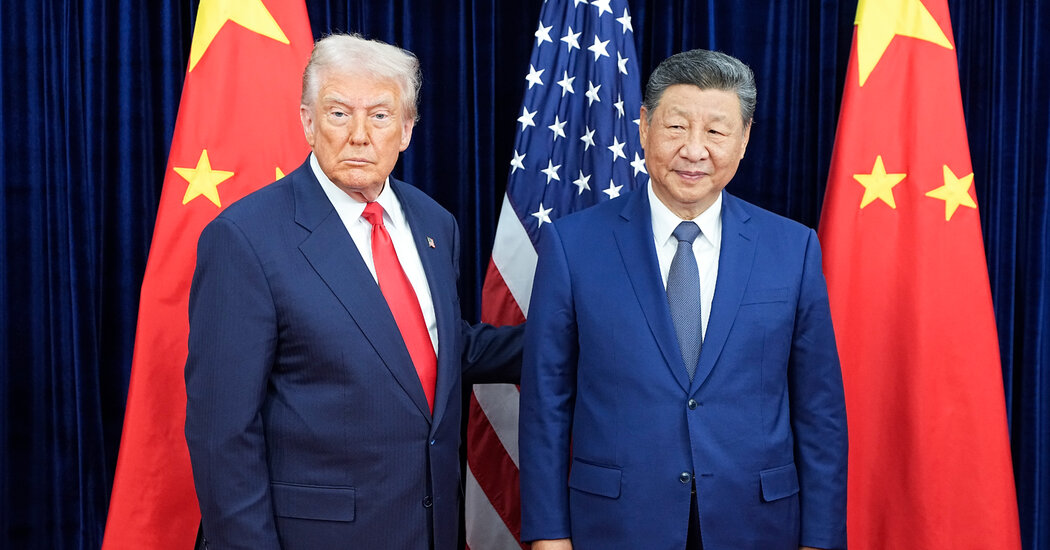The latest on Trump-Xi talks
President Trump and President Xi Jinping of China appear to have covered a lot of ground in their meeting on Thursday in South Korea.
Details have been emerging throughout Thursday, with Trump calling it an “amazing meeting.” Beijing had a more measured response.
But investors appear underwhelmed. It’s unclear whether the two economic powers achieved a true breakthrough, or merely a pause in hostilities from their trade war. Bourses in China and Europe dipped, and S&P 500 futures point to a weak open. Wednesday’s Fed decision and Big Tech earnings could be weighing on investors, too. (More on that below.)
The upshot: The two sides made major, if temporary, concessions. They agreed to delay some of the most punitive trade measures, including on certain tariffs and export curbs.
Also:
-
China agreed to suspend for a year the tight export controls it had placed on rare earth metals this month, a move that potentially removes a pressure point on global supply chains.
-
Trump said that Washington would halve a fentanyl-linked tariff, to 10 percent, because Xi had vowed to work “very hard” to stop the flow of ingredients that the U.S. says are being used to make opioids.
-
China’s Ministry of Commerce said that the U.S. would extend the pause on reciprocal tariffs for another year. (A Nov. 10 deadline had loomed for those levies.)
-
Both sides will suspend tit-for-tat measures against each other’s shipping and shipbuilding industries for a year, including suspending port fees.
-
China also said it had agreed to “expanding agricultural product trade” and to “properly resolve issues related to TikTok.”
-
Trump later wrote on social media that China would buy “massive amounts” of soybeans, and also said that there may be a “very large” purchase of oil and gas from Alaska.
-
And China said that the U.S. agreed to suspend for one year a new rule that put export restrictions on companies at least 50 percent owned by Chinese firms on its “entity” blacklist.
What’s not in the deal — so far: There is no word on key issues, such as the trade in semiconductors for artificial intelligence. This week, Trump had said that “We’ll be speaking about Blackwells,” referring to Nvidia’s high-end chips that Chinese companies seek. Shares of Nvidia fell in premarket trading.
Despite Trump’s assertion, it remains unclear how many American soybeans China will buy, a critical negotiating point for American farmers.
Big questions remain. While the post-meeting messaging has been upbeat — Trump said that “the meeting was a 12” on a scale of zero to 10 — there’s no clear sign that a more durable deal is in the works. A reminder: The last time the leaders met face to face, in 2019, Trump hailed the talks as a breakthrough, only for the two sides to ratchet up trade barriers afterward.
The uncertainty will most likely hang over companies and markets.
On the plus side: Trump said he planned to travel to China to meet with Xi in April, and invited China’s leader to the U.S. for a later visit.
On the down side: Shortly before the meeting, Trump rattled the international community when he wrote on social media that he had “instructed the Department of War” to restart nuclear weapons testing on an “equal basis” with other countries, for the first time in over three decades.
Trump later suggested that the announcement did not have to do with China.
HERE’S WHAT’S HAPPENING
OpenAI is said to be preparing an I.P.O. that could value it at $1 trillion. The ChatGPT maker has considered filing as soon as the second half of 2026, according to Reuters, and has looked at raising $60 billion or probably more. The company may be betting that this is the time to capitalize on investor enthusiasm for A.I. Nvidia, the chipmaker at the center of the A.I. boom, on Wednesday became the first publicly traded company to top a $5 trillion valuation.
Restaurant chains offer a mixed picture on consumer spending. Starbucks announced that its global sales had risen 1 percent last quarter, reversing an almost two-year slide in sales and offering positive news about the coffee chain’s turnaround under its C.E.O., Brian Niccol. But the chain closed 627 stores after months of struggles with weakening consumer spending, an issue that also hit Chipotle Mexican Grill. The food chain’s shares dropped 18 percent in premarket trading after it lowered sales forecasts again as consumers skip dining out.
Layoffs keep coming. General Motors laid off about 1,700 workers at its manufacturing sites on Wednesday, citing a slowdown in the electric vehicle market, while Paramount began cutting more than 2,000 positions, an expected outcome of its merger with the Hollywood studio Skydance. The downsizing comes after this week’s big cuts at Amazon, as well as news that PwC had ditched plans to add 100,000 hires. Such layoffs, and A.I.’s role in them, led Jay Powell, the Fed chair, to say on Wednesday that the bank would be watching the job market “very, very carefully.”
Powell’s ‘slow down’ message
For months, Jay Powell, the Fed chair, has had to contend with President Trump’s broadsides demanding that the central bank lower interest rates, no matter what. Now, Powell has to manage dissent among his fellow Fed policymakers, a fissure that has rattled the markets.
A recap: As expected, the Fed on Wednesday lowered its benchmark lending rate by a quarter point, bringing it under 4 percent for the first time since late 2022. There were two who broke ranks, though, with Stephen Miran, a Fed governor, calling for a half-point cut, and Jeffrey Schmid, the Kansas City Fed president, voting to leave rates unchanged. It was the first dual dissent since 2019.
The next surprise came from Powell. During the news conference explaining the cut, he told reporters multiple times that it would be a mistake to assume the bank would make another trim at its next meeting, in December, a move that many on Wall Street had penciled in.
Citing “strongly differing views” among members of the central bank’s Federal Open Market Committee, Powell said that a move to lower rates at the upcoming meeting “is not a foregone conclusion — far from it.”
The market response was swift. The S&P 500 fell, and the yields on Treasury notes and bonds spiked. (Bond yields climb when prices fall, often as a result of heavy selling.) The futures market on Thursday put the odds of another quarter-point cut in December at 69 percent; it was above 90 percent before Powell started speaking.
Wall Street is rethinking its assumptions. “Chair Powell does not think it is a slam dunk decision, and neither do we,” Sarah House and Michael Pugliese, economists at Wells Fargo, wrote in a research note on Wednesday.
The Fed is contending with contradictory signals. Inflation is running above the central bank’s 2 percent target, and there are continued signs of weakness in the labor market. Powell again said there was “no risk-free path” — meaning that the Fed risked reaccelerating inflation if it were to lower borrowing costs in the hopes of boosting hiring. On the plus side: Overall consumer spending has held up, even if lower income households have pulled back on purchases.
The shutdown is another problem. A lack of official government data has hobbled efforts by the Fed and much of Wall Street to forecast the economy. Powell, for one, is thinking about the brakes.
“What do you do if you’re driving in the fog? You slow down,” he said. “So I’m not committing to that. I’m just saying it’s certainly a possibility that you would say, we really can’t see, so let’s slow down.”
The A.I. spending spree rolls on
Artificial intelligence spending by tech giants shows no signs of slowing. But investors appear to be grading the companies on a tougher curve as they battle for market dominance.
Shares in Meta and Microsoft tumbled in premarket trading. The social media giant behind Facebook and Instagram reported quarterly results that fell short of Wall Street’s expectations, while Microsoft acknowledged that its cloud computing business was still playing catch-up with sky-high demand. Shares in Alphabet, Google’s parent company, zoomed higher after it posed blowout revenues aided by strong demand for its cloud business.
The spending numbers were astounding:
-
The trio spent a combined $78 billion last quarter on capital expenditures — an 89 percent year-on-year rise, according to Deutsche Bank. A big chunk was earmarked for the construction of data centers, and for the purchase of high-end chips and gear to power their A.I. aims.
-
More is on the way: Alphabet, which posted a quarterly profit of nearly $35 billion, forecast that it would spend more than $91 billion this year on capex, a $6 billion increase from its last projections.
-
After reporting a disappointing $2.7 billion quarterly profit, Meta raised its capex projections to $70 billion to $72 billion for the year.
-
Microsoft’s $34.9 billion capex outlay in its latest quarter surpassed its expectations. It notched a profit of nearly $28 billion last quarter.
Will it pay off? The fear in some corners of the market is that the spending blitz could lead to a bubble. “No one needs reminding that history is full of episodes of technology exuberance that eventually left the early investors battered,” Dec Mullarkey, a managing director at SLC Management, told The Financial Times.
Executives remain bullish on A.I. demand. “We will increase our total A.I. capacity by over 80 percent this year, and roughly double our total data center footprint over the next two years,” Satya Nadella, Microsoft’s C.E.O., told investors. But the buildout comes as the company said that its data center capacity could not keep up with demand, spooking investors.
The spending spree appears far from over. Much of that will be spurred by the companies’ breakneck pursuit of what some call artificial general intelligence, or A.I. systems that match the power of human thinking, or more. “There’s a range of timelines” for when superintelligence might come, Mark Zuckerberg, Meta’s C.E.O., said on an analysts call.
“I think that it’s the right strategy to aggressively front-load building capacity, so that way we’re prepared for the most optimistic cases,” he added.
Up next: Amazon and Apple report after the closing bell on Thursday.
THE SPEED READ
Deals
-
Novo Nordisk has made a bid of up to $8.5 billion for the U.S. drugmaker Metsera, topping Pfizer’s offer by more than $1 billion. (CNBC)
-
David Zaslav, Warner Bros. Discovery’s C.E.O., told staff that he needed to see a higher takeover bid to justify selling the company after rejecting three bids from Paramount Skydance. (Bloomberg)
Politics, policy and regulation
-
“Binance Boosted Trump Family’s Crypto Company Ahead of Pardon for Its Billionaire Founder” (WSJ)
-
Character.AI will bar people under 18 from interacting with its A.I. companions as it faces lawsuits over not doing enough to address concerns over child safety. (NYT)
Best of the rest
-
“When This Reporter Comes Calling, the White House Insults Go Flying” (NYT)
-
Jerry Jones, the owner of the Dallas Cowboys, says he’s unlocked a $100 billion bounty of gas to develop some of the hottest, deepest wells in America. (WSJ)
We’d like your feedback! Please email thoughts and suggestions to [email protected].
Andrew Ross Sorkin is a columnist and the founder of DealBook, the flagship business and policy newsletter at The Times and an annual conference.
Bernhard Warner is a senior editor for DealBook, a newsletter from The Times, covering business trends, the economy and the markets.
Sarah Kessler is the weekend edition editor of the DealBook newsletter and writes features on business.
Michael J. de la Merced has covered global business and finance news for The Times since 2006.
Niko Gallogly is a Times reporter, covering business for the DealBook newsletter.
The post Why Investors Seem Underwhelmed by the Trump-Xi Meeting appeared first on New York Times.




